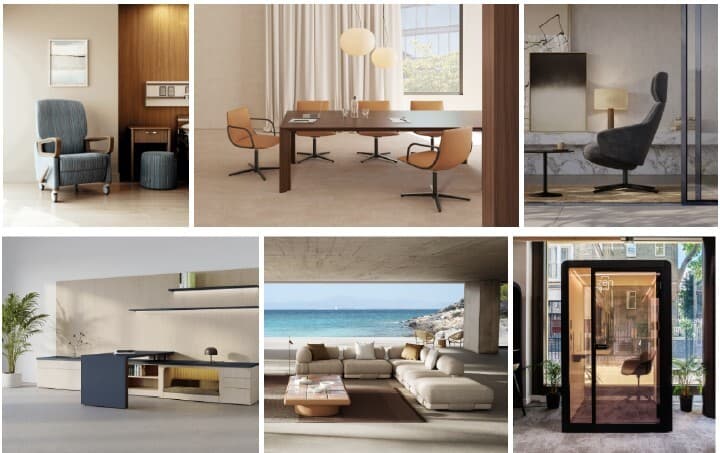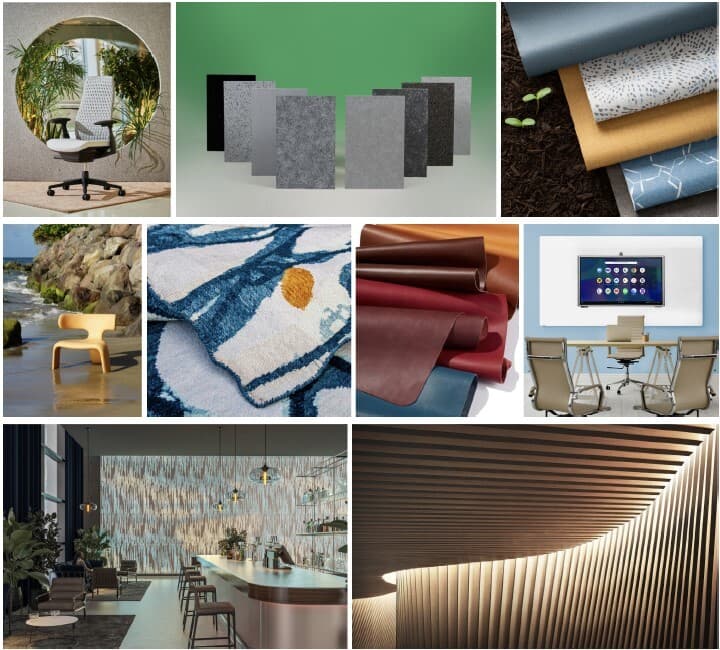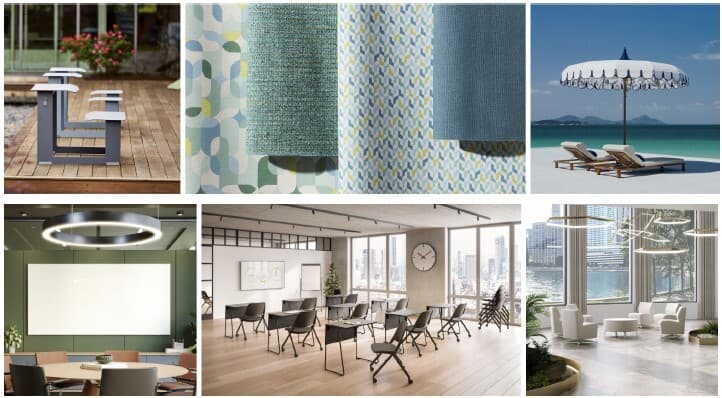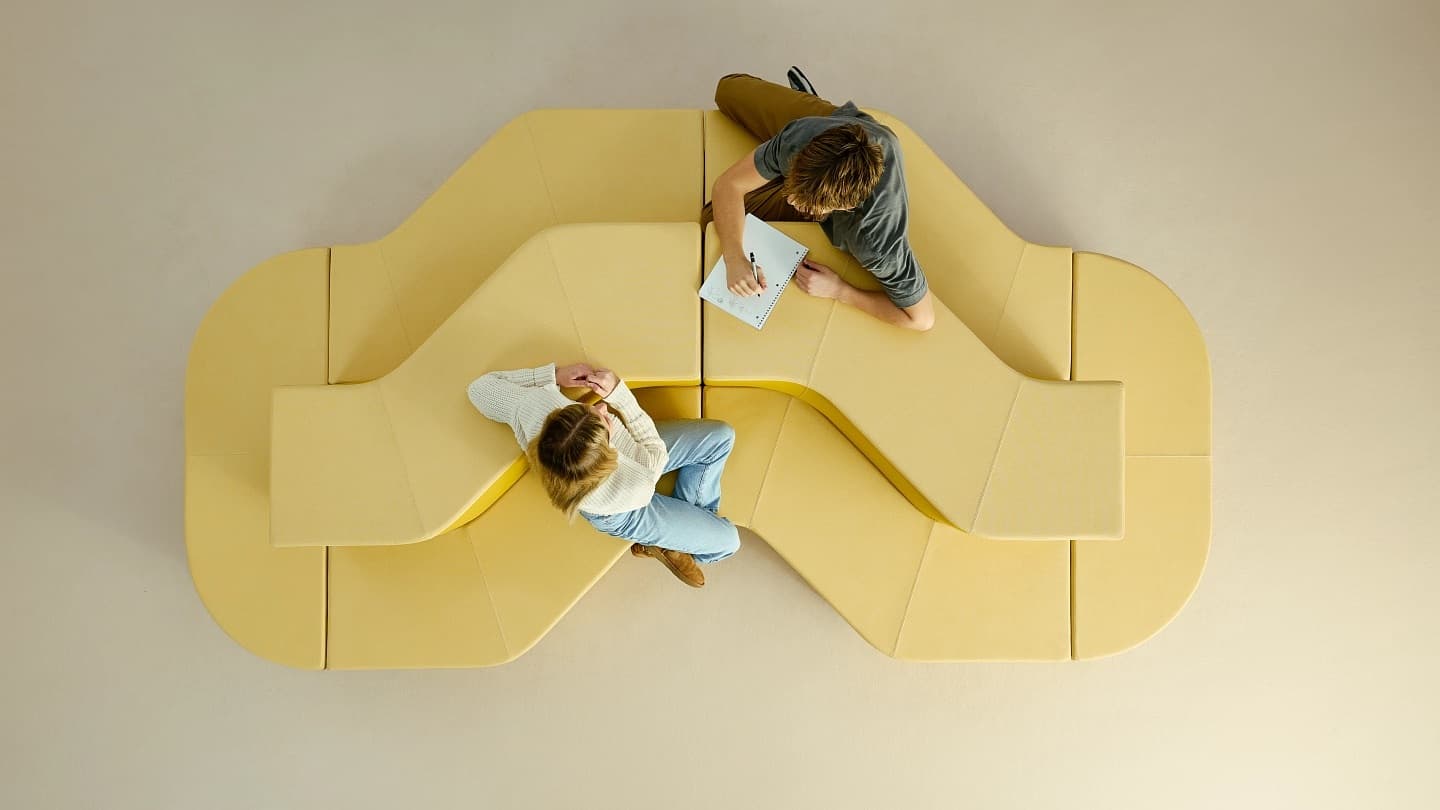New Innovations Reflect Emerging Design Trends Embracing Sensory-Rich Experiences, Multifunctionality, Smart Materials & Technology, and Adaptive Resilience
As the design community looks forward to NeoCon 2025, taking place at THE MART in Chicago on June 9-11, 2025, four influential design themes are gaining momentum—shaping the next chapter of the built environment. Aligned with this year’s narrative, “Design Ahead,” these directions––sensory-based design, cross-sector adaptability, material innovation, and resilience––reimagine how we work, play, learn, heal, and connect. Bridging disciplines and priorities, each trend is grounded by a human-centric philosophy and commitment to sustainability and wellness. Dynamic programming and bold product introductions throughout the 56th edition of the show capture a compelling snapshot of these shifts propelling workplace, hospitality, retail, healthcare, and education spaces forward.
The Sensory Shift: Emotionally Intelligent & Inclusive Design
Emotional well-being and inclusivity are fundamental prerequisites for good design, with neuroaesthetic principles guiding multi-sensory environments that reduce stress, promote healing, and enhance social connection. According to JLL’s Outlook on Design Trends 2025, 58% of employers surveyed cited cultivating culture and belonging as leading motivators for returning to the office, while 46% emphasized meaningful interpersonal connection.
“The concept of neurodiversity is pushing designers to think differently—not just about spaces for those diagnosed with conditions like ADHD, autism, or dyslexia—but for everyone,” comments Pallavi Dean of Dubai-based architecture and interior design studio Roar. “After all, everyone’s brain works uniquely, and a space designed thoughtfully for diverse needs naturally benefits all employees.”
Kay Sargent, Director of Thought Leadership, Interiors at HOK, adds, “Unlike physical barriers, sensory barriers are not always obvious and often go unaddressed. Yet they affect all of us, neurotypicals and neurodivergents alike.”
As the concept of design as a therapeutic tool becomes more widely understood, biophilic design strategies, informed by neuroaesthetics, are reimagining both healthcare and commercial interiors. “This intuitive, non-verbal design language has the power to soothe the brain’s amygdala, lower stress, reduce heart rate, and more,” explains Von Robinson, founder of Play Orbit Studio and designer of Kwalu’s (1199) nature-inspired Ellie Recliner. “In healthcare especially, there’s a move away from cold, harsh, and clinical settings toward spaces that address holistic well-being with natural forms, materials, and rhythms that nurture recovery.”
At this year’s NeoCon, several exhibitors are introducing emotionally attuned products that balance comfort, aesthetic sensitivity, and cognitive support. Viccarbe’s (10-152) pillow-shaped Noha Chair brings residential warmth into shared spaces, while Andreu World’s (300) Calma Lounge embraces the body with enveloping arms, emphasizing restorative comfort. DARRAN’s (3-120) Central Bark collection cleverly rethinks credenzas to include a soft, cleanable bed for Service Animals, complete with warm lighting and integrated storage, addressing the needs of an often overlooked workforce demographic.
In communal spaces, Kettal’s (377) Insula sofa encourages social interaction with smooth lines and generous cushions, while Silen’s (10-155) Zen add-on enables ambient lighting, private smart glass, and immersive soundscapes in any Silen pod to instill a mindful rest. Momentum Textiles & Wallcoverings’ (323) Renaturation Collection by 13&9 Design applies the science of fractal geometry to ground spaces in nature and well-being. Grass by Slalom (7-5062), a bio-based acoustic solution crafted from regenerated plastic, linen, and meadow grass, blends natural elegance with simplicity. Turf’s (1048) Wood Textures integrates digital, artistic patterns inspired by various wood cuts and veneer for a nature-inspired, neuro-inclusive line of acoustic finishes.


Design Without Boundaries: Mobility, Modularity & Multi-Use Spaces
As the lines between work, learning, hospitality, and retail blur, today’s interiors must support multiple modes of engagement—transforming seamlessly from workspace to lounge, classroom to event space. (Think airport lounges doubling as remote workstations and hotel lobbies seamlessly transforming from quiet work zones to vibrant cocktail hubs.) This shift has made mobility, adaptability, and user autonomy essential.
At NeoCon, this evolution is reflected in adaptable furnishings and spatial systems, such as Watson Furniture’s (341) Allé and Safco/OnSemble’s (1054A) Modix System, delivering sleek and reconfigurable desks, storage, and tables designed for evolving spaces, ideal for quick transitions between solo and group interactions. Visplay’s (7-8078) modular Omnio Office blends display and workspace functionality, enabling retail environments to seamlessly transition between brand storytelling, product showcasing, and customer engagement. Dauphin’s (393) Bosselino Uno pod provides compact, private moments in high-traffic environments. Lounge solutions like Prostoria’s (381) Aire, Cane-line’s (7-7070) Sticks Platform sofa, and the Conversa Modular lounge collection by KFI Studios (329) invite endless reconfiguration for comfort and utility. In education and training settings, KI’s (1181) Clamber tiered seating and Nucraft’s (1166) Perspective Table Collection support collaboration and inclusivity through flexible layouts and intentional ergonomics.
Wellness also plays a crucial role in this boundaryless approach. IIDA’s 5 Trends in Healthcare Design emphasizes flexible layouts, warm finishes, and natural light as essential for well-being. In hospitality, this concept now shapes everything from in-room features to adaptive programming. “Wellness isn’t a luxury anymore—it’s a baseline expectation for hotel and resort guests,” comments Landon Shockey, ASID, Senior Interior Designer at HBG Design. “The most successful environments are both sensory-rich and versatile—crafted to evolve with guest needs while creating meaningful, wellness-infused experiences. From thermal spa suites that flex between private and social settings, to treatment rooms designed for emerging wellness modalities, to spaces that transition from daytime retreat to high-energy venue at night, today’s resorts must support how guests want to feel, move, and reconnect to themselves, but on their own terms.”

Materials & Technology Revolution: The Rise of Circular & Smart Design
Sustainability is no longer optional—it’s a driving force in product development and design decisions. Gensler’s 2025 Design Forecast highlights the emergence of a “materials revolution”—driven by the urgent need to address climate risk, carbon reduction, and transparency. Clients are demanding low-impact, circular materials that align with ESG goals and brand values. “Material innovation is no longer a niche interest but a top-tier decision driver,” says Todd Heiser, FIIDA, Regional Managing Principal, Gensler. “The journey to more regenerative spaces begins not with grand gestures, but with the quiet power of mindful materials. In this shared pursuit, designers become storytellers, manufacturers become stewards, and clients become co-authors of a healthier, more hopeful future.”
This realignment has a clear business case: PwC’s State of Decarbonization Report states that sustainable products can deliver up to 25% revenue gains, and a global sustainability study from IBM found that 69% of executives believe sustainability should be a higher priority. In fact, a Marsh McLennan study notes that companies with lower carbon emissions tend to have higher employee satisfaction.
NeoCon exhibitors are meeting the moment with sustainable, high-performance materials. Haworth’s (312) Closed-Loop Manufactured Fern ergonomic office chair utilizes post-production and recycled plastic from end-of-life chairs to create a true closed loop without losing value and utility in the new product. The Good Plastic Company’s (7-3053) Cradle to Cradle® certified Polygood® panels, made from 100% recycled and recyclable post-consumer and post-industrial plastic, transform waste into expressive surfaces suitable for tabletops, furniture, flooring, and beyond. Both Mayer Fabrics' (1173) Hyphyn™ collection of biodegradable vinyl upholstery and Heller’s (1123A) line of indoor and outdoor furniture with Worry Free Plastics utilize anaerobic enzyme technology to ensure high-performance and decomposition at the end-of-life, solely in landfill conditions. Aquafil’s (11-107) Econyl® Bespoke collection of rugs and carpets crafted from 100% post-consumer nylon waste transform ocean plastic and industrial discards into luxurious, durable, circular flooring solutions, while Green Hides’ (1062) USDA biobased and carbon-neutral Sorrento leather is crafted from byproduct hides to reduce impact without sacrificing performance. Further communicating this commitment to circular design, the ReWritten pop-up (1130) showcases a curation of furnishings that have been re-used, re-made, re-upholstered, and re-finished. These innovative solutions highlight a dedication to materials that honor the past and model a more sustainable future.
Technology is also playing a greater role in advancing sustainability and performance—optimizing everything from lighting to ventilation. “We’re entering a new era where materials are no longer passive elements. Metamaterials and programmable matter are allowing us to embed intelligence into the very fabric of our buildings,” says Mark Bryan, Senior Foresight Manager at Future Today Strategy Group.
Exhibitor innovations include Nura Space by Schiavello (10-135)—a platform that uses smart sensors to track desk bookings, meeting room use, and visitor flow for space optimization. Clarus’ (10-102) Lynk™ brings digital collaboration to glass boards with multi-touchscreen functionality and platform integration. Arktura’s (10-154) RGBW Backlighting system transforms perforated panels into programmable, color-rich displays, while Coronet’s (1111) Lalina Family of lighting offers field-cuttable, precision optics with customizable color temperatures and extrusions made from 85% recycled aluminum.
Together, these advancements in materials and technology signal a collective push toward circularity, innovation, and accountability—elevating both ecological and human outcomes in the built environment.

Weathering the Future: Designing for Durability, Longevity, Human & Environmental Resilience
As climate instability, public health concerns, and global supply chain disruptions persist, resilience has become a critical design imperative. ThinkLab reports that 65% of A&D professionals now cite durability as their top product selection factor—marking a pivot toward long-lasting, high-performance solutions designed to meet the challenges of aging infrastructure, climate volatility, and everyday wear. Reinforcing this urgency, ASID’s 2025 Trends Outlook notes that rising natural disasters and temperature extremes are worsening indoor air quality and water safety—highlighting the need for robust, health-focused design solutions.
NeoCon exhibitors are responding to this uncertain future with products engineered for durability and adaptability without compromising aesthetic integrity. OpenSpaces by Smith System (11-111) features weather-resistant outdoor furniture constructed from rugged post-consumer recycled plastic and resilient powder-coated steel that prevents fading, chipping, peeling, and rust for student learning spaces. For high-traffic interiors, Tottori by Ultrafabrics (7-9086) delivers a luxe hand with bleach-cleanable, antimicrobial properties. TUUCI’s (1419) Marquesa Sun Lounge incorporates a seamless, corrosion-resistant frame and precision-leveling base, paired with high-density cushions for lasting outdoor performance. Integra Seating’s (10-140) Seaside Lounge Collection can sustain heavy use with a 1,200 lb. static weight capacity, while its waterfall front and wipe-out feature enable easy cleaning and comfort.
In today’s environment, safety-enhancing tools that bolster public health like UV-C air purification, microbe-resistant materials, and touchless technologies are now must-haves. Formica Group’s (7-4061) TRESPA® TopLab® delivers durable and easy-to-clean worktops with healthcare-grade chemical resistance. Concertex’s (10-103) bio-attributed Kaleido Collection of textiles prioritizes both durability and health-conscious design. In education and high-traffic settings, Ghent’s (1094) Flyte Duo lightweight, dual-sided construction of dry-erasable surfaces offers an impressive 50-year performance warranty. And Source International’s (367) Zenith seating and training tables disassembly and recyclability marry ergonomic comfort with spatial efficiency for meeting rooms, learning environments, auditoriums, and multi-functional spaces.


Deeply interconnected, these four paradigms—The Sensory Shift, Design Without Boundaries, The Materials and Technology Revolution, and Weathering the Future—reposition design not only as an expression of care and inclusion, but as a powerful tool to support both planetary and human well-being.
Attendees can explore these notable concepts and products at NeoCon 2025. Register for complimentary show access here. To view details, including a full list of exhibitors and the programming and events schedule, see here. For more showroom, exhibitor, and general NeoCon news, images, and real-time information, follow NeoCon on: Instagram (@NeoCon_Shows), LinkedIn (@NeoCon-Shows), and Facebook (@NeoConShows).
